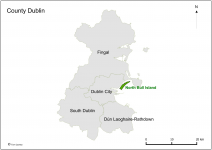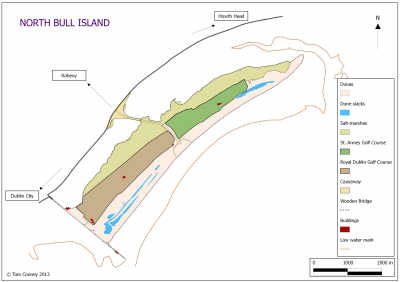North Bull Island National Nature Reserve
Information presented here if for general guidance only.
The wildlife and habitats on the island and inter-tidal areas are protected by Irish and European The owner of this website does not accept responsibility for the safety of visitors. It is strongly advised that visitors should behave sensibly and within the law at all times.
1. DO NOT willfully disturb habitats or species.
2. Check tide times and weather.
3. Wear appropriate weather proof clothing (avoid bright colours).
4. Dogs are domesticated predators and regularly cause disturbance to the islands wildlife...leave them at home.
5. Do not walk out onto the mudflats. It is dangerous and you will disturb wildlife.
Location Maps

 How to get there:
How to get there:
Bus: Dublin Bus 130 (timetable) from the city centre to the Bull Wall (aka Wooden Bridge) and mainland side of the south lagoon.
Train: DART (train service timetable) from Dublin City to Raheny Station. There is a 1 km walk to the causeway which is the main access route onto the island.
Car: the island can be accessed by cars etc either via the Bull Bridge (aka Wooden Bridge) or the causeway. Parking is permitted on the causeway but parking is permitted on a small section of beach near the Bull Wall.
What species can be seen and When?
Spring
Just as the wintering birds depart for their breeding grounds in late February/March, spring migrants start to arrive from Africa. The earliest to be seen are usually wheatears, sand martins and sandwich terns. Areas of scrub are the most reliable places to see a range of migrant bird species such as willow warblers, chiffchaffs and sedge warblers. More unusual species such as grasshopper warbler and whinchat also occur in these areas but are considerably scarcer. Arctic and common terns that nest in Dublin Docks are a regular sight around the island from April onwards.
SummerSeveral pairs of shelduck attempt to nest annually however disturbance and dogs is a regular problem. Although wader numbers are usually quite low in summer several hundred can be present in most including moulting/migratory oystercatchers, bar-tailed godwits, black-tailed godwits, curlew, and dunlins. The island was a regular breeding site for ringed plover and little terns but these are now locally extinct mainly due to excessive disturbance at the traditional nesting site.
Autumn
Post-breeding waders start to arrive in July but the main passage migration occurs from late August to October. A careful look through these flocks unusually reveals unusual but regular species such as little stint, curlew sandpiper and ruff. Rare waders such as buff-breasted sandpiper and pectoral sandpiper and other North American species occur occasionally. The first flocks of Teal and Wigeon arrive in late August with Pintails a little later. The earliest Brent Geese usually put in an appearance in the second half of September with the main arrival in late October.
Winter
Over 30,000 thousand waders, wildfowl and gulls winter in Dublin Bay annually and most roost on North Bull Island at high tide. The large concentration of birds on the saltmarshes and mudflats attracts peregrines and merlins. Divers, grebes, common scoter and goldeneye feed in the deeper waters off the beach and Bull Wall. Large flocks of finches are regular in the vicinity of the causeway and are always worth checking for the increasing rare twite. A few short-eared owls winters on the island but these are rarely encountered. In most years snow buntings occur and can be found feeding along the beach tide line and dunes nearest the Bull Wall.